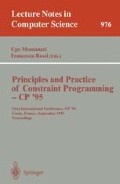Abstract
Distributed software problems can be particularly mystifying to diagnose, for both system users and system administrators. Modelbased diagnosis methods that have been more commonly applied to physical systems can be brought to bear on such software systems. A prototype system has been developed for diagnosing problems in software that controls computer networks. Our approach divides this software into its natural hierarchy of layers, subdividing each layer into three separately modeled components: the interface to the layer above on the same machine, the protocol to the same layer on a remote machine, and the configuration. For each component knowledge is naturally represented in the form of constraints. User interaction modeling is accomplished through the introduction of constraints representing user assumptions, the finite-state machine specification of a protocol is translated to a standard CSP representation and configuration tasks are modeled as dynamic CSPs. Diagnosis is viewed as a partial constraint satisfaction problem (PCSP). A PCSP algorithm has been adapted for use as a diagnostic engine. This paper presents a case study illustrating the diagnosis of some problems involving the widely used FTP and DNS network software.
Preview
Unable to display preview. Download preview PDF.
References
Albitz, P. and Liu, C., DNS and BIND, O'Reilly & Associates, Inc., Sebastopol, CA, 1994.
Bakker, R.R., Dikker, F., Tempelman, F. and Wognum, P.M., Diagnosing and solving over-determined constraint satisfaction problems, Proceedings of the 13th International Joint Conference on Artificial Intelligence, 1, 276–281, 1993.
Bouloutas, A.T., Modeling Fault Management in Communication Networks, PhD Thesis, Columbia University, 1990.
Comer, D.E., Internetworking with TCP/IP, vol. 1, Prentice Hall, Inc., Englewoods Cliffs, NJ, 1991.
DEC OSF/1, Configuring Your Network Software, Digital Equipment Corporation, 1993.
El Fattah, Y. and Dechter, R., Empirical Evaluation of Diagnosis as Optimization in Constraint Networks, Working Papers of The Third International Workshop on Principles of Diagnosis (DX-92), (1992).
Freuder, E.C. and Mackworth, A.K., Special Volume, Constraint-Based Reasoning, Artificial Intelligence, 58, 1992.
Freuder, E.C. and Wallace, R.J., Partial Constraint Satisfaction, Artificial Intelligence, 58, 21–71, 1992.
Ghedamsi, A., von Bochmann, G. and Dssouli, R., Diagnosing multiple faults in finite state machines, Technical Report, Dept. d'IRO, Universite de Montreal, Canada, January 1993.
Hamscher, W., Console, L. and de Kleer, J., editors, Readings in Model-based Diagnosis, Morgan Kaufmann Publishers, Inc., San Mateo, CA, 1992.
Hunt, C., TCP/IP Network Administration, O'Reilly & Associates, Inc., Sebastopol, CA, 1994.
ISO, ISO Open Systems Interconnection — Basic Reference Model, Second Edition, ISO/TC 97/SC 16(ISO CD 7498-1), 1992.
Lin, Y. J. and Wuu, G., A constraint approach for temporal intervals in the analysis of timed transitions, Protocol Specification, Testing and Verification, XI, 215–230, 1991.
Miller, M.A., Troubleshooting TCP/IP, M&T Books, 1993.
Mittal, S. and Falkenhainer, B., Dynamic Constraint Satisfaction Problems, Proceedings of the Eighth National Conference on Artificial Intelligence (AAAI-90), 25–32, 1990.
Mittal, S., Reasoning about Resource Constraints in Configuration Tasks, SSL Technical Report, XEROX Park, 1990.
Mittal, S. and Frayman, F., Towards a Generic Model of Configuration Tasks, Proceedings of the Eleventh International Joint Conference on Artificial Intelligence, 2, 1395–1401, 1989.
Mockapetris, P., Domain Names — Concepts and Facilities, Request For Comments 1034, 1987.
Postel, J., File Transfer Protocol, Request For Comments 959, ISI, October 1985.
Riese, M., Model-based Diagnosis of Communication Protocols, PhD Thesis, Swiss Federal Institute of Technology, Lausanne, 1993.
Wang, C.J. and Liu, M.T., A test suite generation method for extended finite state machines using axiomatic semantics approach, Protocol Specification, Testing and Verification, XII, 29–43, 1992.
Author information
Authors and Affiliations
Editor information
Rights and permissions
Copyright information
© 1995 Springer-Verlag Berlin Heidelberg
About this paper
Cite this paper
Sabin, D., Sabin, M., Russell, R.D., Freuder, E.C. (1995). A constraint-based approach to diagnosing software problems in computer networks. In: Montanari, U., Rossi, F. (eds) Principles and Practice of Constraint Programming — CP '95. CP 1995. Lecture Notes in Computer Science, vol 976. Springer, Berlin, Heidelberg. https://doi.org/10.1007/3-540-60299-2_28
Download citation
DOI: https://doi.org/10.1007/3-540-60299-2_28
Published:
Publisher Name: Springer, Berlin, Heidelberg
Print ISBN: 978-3-540-60299-6
Online ISBN: 978-3-540-44788-7
eBook Packages: Springer Book Archive

